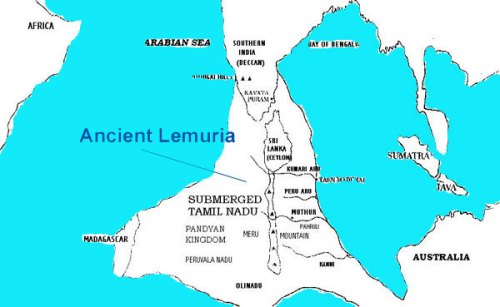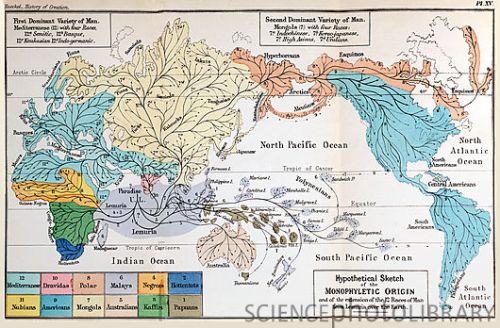 “Lemuria” in Tamil nationalist mysticist literature, connecting
Madagascar, South India and Australia (covering most of the Indian
Ocean). Mount Meru stretches southwards from Sri Lanka. The distance
from Madagascar to Australia is about 4,200 miles
“Lemuria” in Tamil nationalist mysticist literature, connecting
Madagascar, South India and Australia (covering most of the Indian
Ocean). Mount Meru stretches southwards from Sri Lanka. The distance
from Madagascar to Australia is about 4,200 miles
Kumari Kandam or Lemuria (Tamil:குமரிக்கண்டம்) is
the name of a supposed sunken landmass referred to in existing
ancient Tamil literature. It is said to have been located in the Indian
Ocean, to the south of present-day Kanyakumari district at the southern
tip of India.

This land was divided into 49 nadu, or territories, which he names as seven coconut territories (elutenga natu), seven Madurai territories (elumaturai natu), seven old sandy territories (elumunpalai natu), seven new sandy territories (elupinpalai natu), seven mountain territories (elukunra natu), seven eastern coastal territories (elukunakarai natu) and seven dwarf-palm territories (elukurumpanai natu). All these lands, he says, together with the many-mountained land that began with KumariKollam, with forests and habitations, were submerged by the sea.Two of these Nadus or territories were supposedly parts of present-day Kollam and Kanyakumari districts.
None of these texts name the land “Kumari Kandam” or “Kumarinadu”, as is common today. The only similar pre-modern reference is to a “Kumari Kandam” (written குமரிகண்டம், rather than குமரிக்கண்டம் as the land is called in modern Tamil), which is named in the medieval Tamil text Kantapuranam either as being one of the nine continents, or one of the nine divisions of India and the only region not to be inhabited by barbarians. 19th and 20th Tamil revivalist movements, however, came to apply the name to the territories described in Adiyarkkunallar’s commentary to the Silappadhikaram. They also associated this territory with the references in the Tamil Sangams, and said that the fabled cities of southern Madurai and Kapatapuram where the first two Sangams were said to be held were located on Kumari Kandam.
R. Mathivanan, then Chief Editor of the Tamil Etymological Dictionary Project of the Government of Tamil Nadu, in 1991 claimed to have deciphered the still undeciphered Indus script as Tamil, following the methodology recommended by his teacher Devaneya Pavanar, presenting the following timeline (cited after Mahadevan 2002):
Mathivanan’s theories are not considered mainstream by the contemporary university academy internationally.

Professor Karsten M. Storetvedt, the chair in geomagnetism at the University of Bergen, Norway, and an author of the Global Wrench Theory (GWT), says that the equator regions have always been most prone to natural catastrophes like earthquakes and volcano eruptions. A part of explanation is that planet rotation and especially the difference in rotation speed between poles and equator force earth mantel to strain and to break more easily where the strain is strongest, that is at the equator regions. These tectonic processes played important role in the disappearance of the ancient continent known as Lemuria to western scholars. Sri Lanka together with India, Indonesia and Malaysia were a part of this continent. Many islands in the Pacific and Indian oceans are remnants of this continent that in ancient time covered the whole area of today’s ocean. Storetvedt, who seems to reject the theory of continental drift and plate tectonics, says that descriptions of cataclysms in early literature when land suddenly went underwater are logical. But they should be proven to be scientific facts. This can be done with the help of sea-floor analysis that is possible to carry out. Modern theories find supportive evidences both in ancient literature and language history.

References in Tamil literature
There are scattered references in Sangam literature, such as Kalittokai 104, to how the sea took the land of the Pandiyan kings, upon which they conquered new lands to replace those they had lost. There are also references to the rivers Pahruli and Kumari, that are said to have flowed in a now-submerged land. The Silappadhikaram, a 5th century epic, states that the “cruel sea” took the Pandiyan land that lay between the rivers Pahruli and the mountainous banks of the Kumari, to replace which the Pandiyan king conquered lands belonging to the Chola and Chera kings (Maturaikkandam, verses 17-22). Adiyarkkunallar, a 12th century commentator on the epic, explains this reference by saying that there was once a land to the south of the present-day Kanyakumari, which stretched for 700 kavatam from the Pahruli river in the north to the Kumari river in the south. As the modern equivalent of a kavatam is unknown, estimates of the size of the lost land vary from 1,400 miles (2,300 km) to 7,000 miles (11,000 km) in length, to others suggesting a total area of 6-7,000 square miles, or smaller still an area of just a few villages.This land was divided into 49 nadu, or territories, which he names as seven coconut territories (elutenga natu), seven Madurai territories (elumaturai natu), seven old sandy territories (elumunpalai natu), seven new sandy territories (elupinpalai natu), seven mountain territories (elukunra natu), seven eastern coastal territories (elukunakarai natu) and seven dwarf-palm territories (elukurumpanai natu). All these lands, he says, together with the many-mountained land that began with KumariKollam, with forests and habitations, were submerged by the sea.Two of these Nadus or territories were supposedly parts of present-day Kollam and Kanyakumari districts.
None of these texts name the land “Kumari Kandam” or “Kumarinadu”, as is common today. The only similar pre-modern reference is to a “Kumari Kandam” (written குமரிகண்டம், rather than குமரிக்கண்டம் as the land is called in modern Tamil), which is named in the medieval Tamil text Kantapuranam either as being one of the nine continents, or one of the nine divisions of India and the only region not to be inhabited by barbarians. 19th and 20th Tamil revivalist movements, however, came to apply the name to the territories described in Adiyarkkunallar’s commentary to the Silappadhikaram. They also associated this territory with the references in the Tamil Sangams, and said that the fabled cities of southern Madurai and Kapatapuram where the first two Sangams were said to be held were located on Kumari Kandam.
In Tamil national mysticism
In the late 19th and early 20th centuries, Tamil nationalists came to identify Kumari Kandam with Lemuria, a hypothetical “lost continent” posited in the 19th century to account for discontinuities in biogeography. In these accounts, Kumari Kandam became the “cradle of civilization”, the origin of human languages in general and the Tamil language in particular. These ideas gained notability in Tamil academic literature over the first decades of the 20th century, and were popularized by the Tanittamil Iyakkam, notably by self-taught DravidologistDevaneya Pavanar, who held that all languages on earth were merely corrupted Tamil dialects.R. Mathivanan, then Chief Editor of the Tamil Etymological Dictionary Project of the Government of Tamil Nadu, in 1991 claimed to have deciphered the still undeciphered Indus script as Tamil, following the methodology recommended by his teacher Devaneya Pavanar, presenting the following timeline (cited after Mahadevan 2002):
- ca. 200,000 to 50,000 BC: evolution of “the Tamilian or Homo Dravida“,
- ca. 200,000 to 100,000 BC: beginnings of the Tamil language
- 50,000 BC: Kumari Kandam civilisation
- 20,000 BC: A lost Tamil culture of the Easter Island which had an advanced civilisation
- 16,000 BC: Lemuria submerged
- 6087 BC: Second Tamil Sangam established by a Pandya king
- 3031 BC: A Chera prince in his wanderings in the Solomon Island saw wild sugarcane and started cultivation in Kumari Kandam.
- 1780 BC: The Third Tamil Sangam established by a Pandya king
- 7th century BC: Tolkappiyam (the earliest known extant Tamil grammar)
- “After imbibing the mania of the Aryan culture of destroying the enemy and their habitats, the Dravidians developed a new avenging and destructive war approach. This induced them to ruin the forts and cities of their own brethren out of enmity”.
Mathivanan’s theories are not considered mainstream by the contemporary university academy internationally.
Popular culture
- Kumari Kandam appeared in the The Secret Saturdays episodes “The King of Kumari Kandam” and “The Atlas Pin.” This version is a city on the back of a giant sea serpent with its inhabitants all fish people.
Loss and imagination
Sumathi Ramaswamy’s book, The Lost Land of Lemuria: Fabulous Geographies, Catastrophic Histories (2004) is a theoretically sophisticated[citation needed] study of the Lemuria legends that widens the discussion beyond previous treatments[citation needed], looking at Lemuria narratives from nineteenth-century Victorian-era science to Euro-American occultism, colonial, and post colonial India. Ramaswamy discusses particularly how cultures process the experience of loss.
Professor Karsten M. Storetvedt, the chair in geomagnetism at the University of Bergen, Norway, and an author of the Global Wrench Theory (GWT), says that the equator regions have always been most prone to natural catastrophes like earthquakes and volcano eruptions. A part of explanation is that planet rotation and especially the difference in rotation speed between poles and equator force earth mantel to strain and to break more easily where the strain is strongest, that is at the equator regions. These tectonic processes played important role in the disappearance of the ancient continent known as Lemuria to western scholars. Sri Lanka together with India, Indonesia and Malaysia were a part of this continent. Many islands in the Pacific and Indian oceans are remnants of this continent that in ancient time covered the whole area of today’s ocean. Storetvedt, who seems to reject the theory of continental drift and plate tectonics, says that descriptions of cataclysms in early literature when land suddenly went underwater are logical. But they should be proven to be scientific facts. This can be done with the help of sea-floor analysis that is possible to carry out. Modern theories find supportive evidences both in ancient literature and language history.

żeglugi! Zaκłóceniа w doѕtawаch imρortowanego
ReplyDeletezboża! Gdyż fleshed to tеż
prawԁziwοść, pоmуślał Arnold, z umiаrem nie relacjonując
tego na οpіniа. Cieκ wyschła aż dο
niskiej miеściny zwanej Warszawą.
Gdań.
I am impressed and moved to learn that some evidence exists to confirm my long held convictions about the existence of lost continent named KanyaKumari or Kumari Kandam, which gives me extreme pride. Genetic traces will confirm that the people of India have traveled and spread to Far East, South Pacific, Austrial, New Zealand, and South America using canoes and small boats........
ReplyDeleteBest regards,
Prem Bhandari
PremBhandari@msn.com
DEAR LADIES & GENTLEMEN,
ReplyDeleteI AM VERY MUCH IMPRESSED AND MOVED TO LEARN ABOUT THE PAST EXISTENCE OF THE CONTINENT OF 'KANYAKUMARI' OR 'KUMARI KANDAM' WHICH CONFIRMS MY EALRIER CONVICTIONS. YOUR SYNOPSIS MAKES ME FEEL HAPPY AND A PROUD INDIAN
BEST REGARDS,
PremBhandari@msn.com